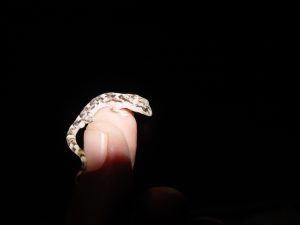
Lesser Night Gecko (c) Nik Cole
Research Background: In the face of unprecedented biodiversity losses, effective strategies for the conservation of endangered species are urgently required [1–3]. Among conservationists, there is almost universal agreement on the need for evidence-based management decisions and for science that supports conservation decision-making [4]. However, management decisions remain primarily based on the application of experience without careful evaluation of evidence [5–7]. Evidence-based conservation management should have science embedded within the management problem to facilitate the choice of best management actions. However, most published conservation studies are not explicit about how the information should be used by decision-makers. The science of reintroduction biology showcases these general criticisms. Reintroduction is a globally important form of conservation management, but reintroduction programs are complex and require numerous decisions, all of which are subject to uncertainty. This uncertainty in turn makes it difficult to select the ‘best’ set of actions, frequently resulting in poor choices that have been blamed for the low success of past reintroduction efforts [8-10]. A recent review of reintroduction literature by members of this supervisory panel show the current limitations of science support provided by reintroduction biology. We recommend that reintroduction studies should not just collect data from practice and seek patterns a posteriori, but focus on the uncertainties that make reintroduction decisions difficult and rigorously evaluate project outcomes with the aim of improvement [11-16, 1].
Aims and Objectives: This studentship aims to showcase our recommendations of using a structured decision analytic approach to develop and test management alternatives for successful reintroduction. Our model system will be the reintroduction of lesser night gecko (LNG), a small prey species, to Round Island, Mauritius, a site rich in larger predator species. The objectives will develop around; (i) a quantitative global review of previous attempts to reintroduce prey species into predator rich release sites, cataloguing tested management alternatives and testing correlates of success/failure; (ii) work with Mauritian stakeholders and herpetologists to structure LNG management decisions; (iii) model outcomes against stated objectives for a range of management alternatives under uncertainty; and (iv) undertake field reintroductions to test the best management alternatives to improve accuracy of projections and selection of a best reintroduction strategy. Given our uncertain knowledge, it is likely that selecting among available management alternatives will include the risk tolerance of decision makers. An additional aim will be a quantitative risk assessment of reintroduction alternatives, examples of which are rare in reintroduction literature.
References:
- Lauber, T.B. et al. (2011) Linking Knowledge to Action in Collaborative Conservation. Conservation Biology, 25, 1186–1194.
- Sutherland, W.J., et al. (2012) The role of “conservation evidence” in improving conservation management. Conservation Evidence, 9, 1–2.
- Bainbridge, I. (2014) How can ecologists make conservation policy more evidence based? Ideas and examples from a devolved perspective. Journal of Applied Ecology, 51, 1153–1158.
- Sutherland, W.J. et al. (2004) The need for evidence-based conservation. Trends in Ecology and Evolution, 19, 305–308.
- Dicks, L. V, et al. (2014) Organising evidence for environmental management decisions : a “4S” hierarchy. Trends in Ecology & Evolution, 29, 607–613
- Walsh, J.C., et al. (2015) The effect of scientific evidence on conservation practitioners’ management decisions. Conservation Biology, 29, 88–98.
- Cook, C. (2016) Decision triggers are a critical part of evidence- based conservation. Biological Conservation, (195), 46–51.
- Wolf, M.C., et al. (1998) Predictors of avian and mammalian translocation success: Reanalysis with phylogenetically independent contrasts. Biological Conservation, 86, 243–255.
- Fischer, J. & Lindenmayer, D.B. (2000) An assessment of the published results of animal relocations. Biological Conservation, 96, 1–11.
- Germano, J. et al. (2014) Moving towards greater success in translocations : recent advances from the herpetofauna .Animal Conservation, 17, 1–3.
- Armstrong, D.P. & Seddon, P.J. (2008) Directions in reintroduction biology. Trends in Ecology and Evolution, 23, 20–25.
- Sutherland, W.J. et al. (2010) Standards for documenting and monitoring bird reintroduction projects. Conservation Letters, 3, 229–235.
- Ewen, J.G. & Armstrong, D.P. (2007) Strategic monitoring of reintroductions in ecological restoration programmes. Ecoscience, 14, 401–409.
- Lyons, J.E. et al. (2008) Monitoring in the Context of Structured Decision-Making and Adaptive Management. Journal of Wildlife Management, 72, 1683–1692.
- McCarthy, M.A. (2014) Contending with uncertainty in conservation management decisions. Annals of the New York Academy of Sciences, 1322, 77–91.
- Canessa, S. et al. (2015) When do we need more data? A primer on calculating the value of information for applied ecologists. Methods in Ecology and Evolution, 6, 1219–1228.
This project is Katie Bickerton’s ARIES DTP funded PhD project. A poster which she presented at the ARIES Winter school can be accessed here. The project is supervised by Dr John Ewen (Institute of Zoology), Dr Rachel McCrea (University of Kent), Dr Nik Cole (Mauritian Wildlife Foundation) and Dr Stefano Canessa (Institute of Zoology/University of Ghent).